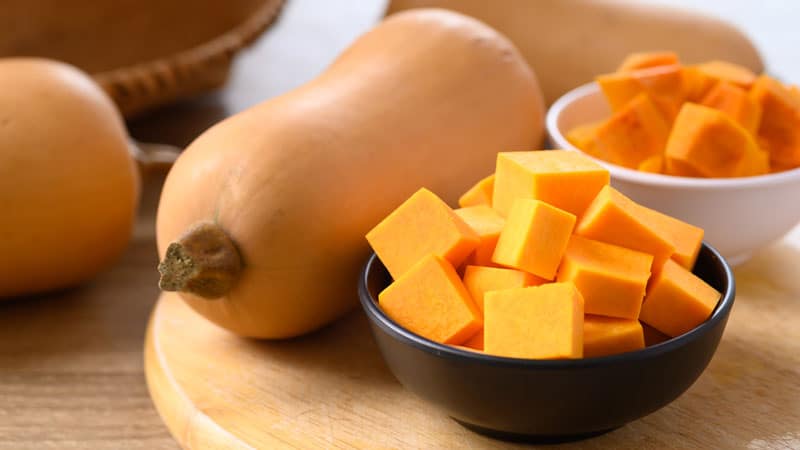
Butternut squash is an honorary member of the Winter squash gang. It’s so popular, we can actually find it all-year-round. Its creamy consistency and mild flavor makes it a great ingredient for soups, sauces, and baby food. We can also cook it in cubes to serve as part of salads or Budha bowls, or we can cut them in half and roast them faced down, and then stuff them with grains, legumes, mushrooms… you name it!
Oh, and if you prefer your squash to be sweeter, you should try butternut squash and buttercup squash’s love baby: honeynut squash. It was derived from these two back in the 80s, but it’s becoming much more popular now.
When it comes to nutrition, butternut squash is packed with vitamin A. One cup of baked cubes gives us almost twice our daily requirement! Other nutrients present include fiber, vitamin B3, vitamin B5, vitamin B6, vitamin C, vitamin E, magnesium, manganese, and potassium. We do get more nutrition if we cook our butternut squash from fresh instead of buying it frozen. But, if you need a quick fix, you can still get some good benefits from your frozen squash.
Butternut squash is great for our gut, our heart, our immunity, our eyes, our lungs, our metabolism, our brain, our red blood cells, our bones, our connective tissue, our muscles, our cells, and our children’s early development.
When it comes to pesticide content, winter squash made it into The Middle of the List by the Environmental Working Group (EWG), this means it’s not clean enough to make it into the Clean 15 or dirty enough to get into the Dirty Dozen. If you can’t find organic, you should be fine getting conventional butternut squash. Just make sure you wash it before cutting and cooking it.
Try our personalized nutrition calculator below to see just how much nutrition you and your family can get from butternut squash.
Butternut Squash Nutrition Calculator
Use our personalized nutrition calculator to discover the percentage of daily nutrition needs you and your family can get from eating butternut squash.
Nutrition needs vary according to age, sex, and whether women of reproductive age are pregnant or breastfeeding. Fill out the form below for yourself and for your family members to get personalized results.*
* Calculated as a percentage of the Recommended Daily Allowances (RDAs) as established by the U.S. Department of Agriculture and the U.S. Department of Health and Human Services. Based on nutritional information provided by the U.S. Department of Agriculture as an average of multiple fresh and frozen, cooked samples.
References
